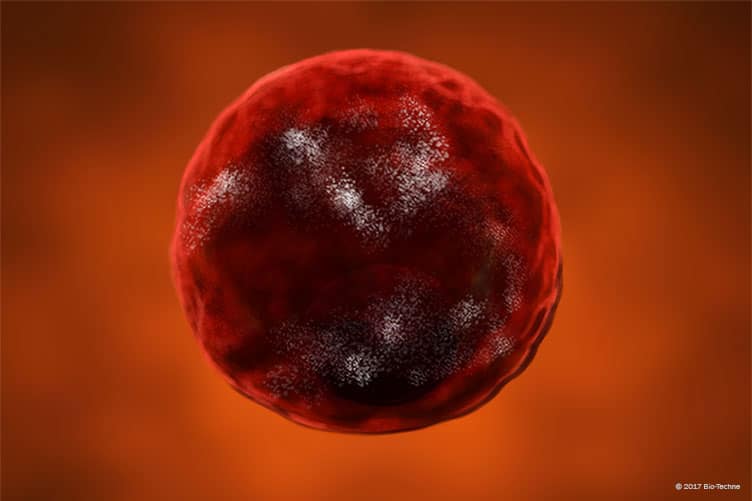NCR- ILC3 Cell Markers
Click on one of the ILC subsets shown in the buttons below to see the markers that are commonly used to identify each cell type.

CD1a-
CD3-
CD11c-
CD14-
CD19-
CD34-
CD94-
DLEC/CLEC4C/BDCA-2-
Fc gamma RIII/CD16-
Fc epsilon RI-
IL-3 R alpha/CD123-
TCR alpha/beta-
TCR gamma/delta-
MOUSE
CD3-
CD19-
B220/CD45 R-
CD5-
CD11b-
Gr-1/Ly6G-
Ter-119-
A note regarding Lin- Markers
Overview
Group 3 ILCs (ILC3s) are a subset of innate lymphoid cells (ILCs) that is considered to be the innate equivalent of Th17 or Th22 cells based on similarities in their functions and the molecules that they produce. Like Th17 cells, ILC3s are activated by extracellular bacteria and fungi, they depend on the transcription factor ROR gamma t for their development and function, and they produce either IL-17 and IL-22, or IL-22 alone. While human ILC3s express toll-like receptors and can be activated either directly or indirectly, mouse ILCs lack pattern recognition receptors and therefore can only be activated indirectly by cytokines or other inflammatory mediators released by epithelial or myeloid cells. Both human and mouse ILC3s are activated in the presence of IL-23, IL-1 alpha, IL-1 beta, IL-7, TL1A, and prostaglandin E2 (PGE2), and like other ILCs, they are primarily localized to mucosal tissues and lack rearranged antigen receptors. In both humans and mice, ILC3s are a heterogeneous cell population that includes both natural cytotoxicity receptor negative (NCR-) cells, such as fetal lymphoid tissue inducer (LTi) cells and postnatal LTi-like cells, and NCR positive (NCR+) cells. In mice, (NCR-) ILC3s are CCR6+ NKp46- cells, while (NCR+) ILC3s (originally known as NK-22 cells) are CCR6- NKp46+ cells. Both subsets produce IL-22, but unlike mouse (NCR+) ILC3s, (NCR-) ILC3s also produce IL-17. Additionally, both subsets of mice ILC3s express CD90/Thy1, CD117/c-kit, and CD127/IL-7 R alpha, and lack expression of lineage markers (Lin-) that are used to identify other immune cell types. Similar to mouse ILC3s, human (NCR+) and (NCR-) ILC3s both express CD117/c-kit and CD127/IL-7 R alpha, but they also homogeneously express CCR6. As a result, the human (NCR+) and (NCR-) ILC3 subsets are typically distinguished from each other based on the expression of NKp44 on (NCR+) ILC3s and the lack of expression of this marker on (NCR-) ILC3s. Unlike mouse (NCR-) and (NCR+) ILC3s, which both produce IL-22, IL-22 production by human ILC3s is primarily attributable to the (NCR+) ILC3 subset.
Data Examples
Detection of Cell Surface Markers on ILCs from Mouse Peyer’s Patches by Flow Cytometry. (A) Single cell suspensions were obtained from mouse Peyer’s patches and stained with a mouse lineage marker cocktail containing Alexa Fluor®700-conjugated monoclonal antibodies against CD3, B220, Ter-119, CD11b/Integrin alpha M, Gr-1, and CD5 (R&D Systems, Catalog # FLC001N). Lineage negative cells (CD3-, B220-, Ter-119-, CD11b/Integrin alpha M-, Gr-1-, and CD5-) were gated on by flow cytometry. (B) CD117+ CD127+ ILCs in the lineage negative population were detected by staining with an APC-conjugated Rat Anti-Mouse CD117/c-kit Monoclonal Antibody (R&D Systems, Catalog # FAB1356A) and an Alexa Fluor®488-conjugated Rat Anti-Mouse CD127/IL-7 R alpha Monoclonal Antibody (R&D Systems, Catalog # FAB47742G). (C) NKp46 and CD25/IL-2 R alpha were detected on Lin- CD117+ CD127+ ILCs by staining with a PE-conjugated Rat Anti-Mouse NKp46/NCR1 Monoclonal Antibody (R&D Systems, Catalog # FAB22252P) and a PerCP-conjugated Rat Anti-Mouse CD25/IL-2 R alpha Monoclonal Antibody (R&D Systems, Catalog # FAB2438C).

